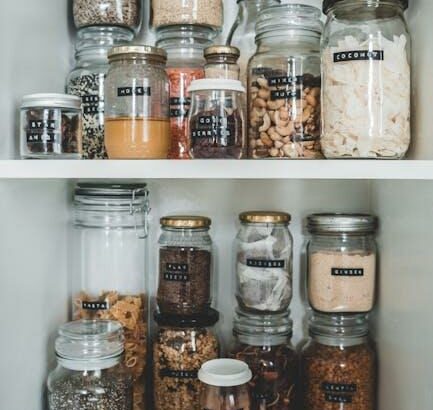Step into any kitchen and you’ll find that the pantry is the unsung hero, quietly keeping everything in order and making mealtime a breeze. But what happens when chaos takes over and finding that can of beans feels more like a treasure hunt? Fear not, because this article is here to help you reclaim your pantry and turn it into a well-oiled, organized machine. From categorizing your items to utilizing space-saving solutions, we’ll show you how to transform your pantry into a clean and efficient haven for all your culinary delights. So, roll up your sleeves and get ready to declutter, label, and stack your way to pantry perfection!
Table of Contents
- Declutter Your Space: Embrace Minimalism
- Embrace Transparent Storage Solutions
- Categorize for Clarity: Zone Your Pantry
- Perfecting Pantry Accessibility: Lazy Susans and Pull-Out Shelves
- Label Like a Pro: Never Guess Contents Again
- First In, First Out: The Rotation Rule
- Adjustable Shelving: Adapt to Your Needs
- Moisture and Pests: Safeguarding Your Supplies
- Use Vertical Space: Stack Smarter, Not Harder
- Maintain with a Monthly Audit: Keep It Systematic
- Questions & Answers for Organizing Your Pantry for Cleanliness and Efficiency
- The Way Forward
Declutter Your Space: Embrace Minimalism
Have you ever opened your pantry only to be met with a chaotic jumble of cans, boxes, and bags? Organizing your pantry is the key to maximizing efficiency and cleanliness in your kitchen.
Here are some practical tips to help you declutter your pantry and embrace minimalism.
1. Take Inventory
Start by taking everything out of your pantry and assessing what you have. Check the expiration dates on items and get rid of anything that is past its prime. Group similar items together, such as canned goods, baking supplies, and snacks, and take note of what you use most often.
2. Utilize Storage Solutions
Invest in a variety of storage containers to keep your pantry organized and tidy. Clear containers allow you to easily see what’s inside, while labeled containers help you quickly find what you need. Use stackable bins, shelves, and lazy susans to make the most of your space.
3. Arrange Items Strategically
Place frequently used items at eye level for easy access, and store heavier items on lower shelves. Use the top shelves for items that you don’t use as often. Arrange your pantry in a way that makes sense for your cooking habits, keeping related items together.
4. Maintain Regularly
Once you’ve organized your pantry, make it a habit to regularly check and tidy up the space. Rotate older items to the front and keep an ongoing shopping list on your pantry door to stay on top of what you need to restock.
In summary, organizing your pantry for cleanliness and efficiency is essential for keeping a streamlined and functional kitchen. By taking inventory, utilizing storage solutions, arranging items strategically, and maintaining regularly, you can transform your pantry into a well-organized and welcoming space. Embrace minimalism in your pantry and reap the benefits of a more efficient cooking experience.
Embrace Transparent Storage Solutions

When it comes to Organizing Your Pantry, one of the best things you can do for cleanliness and efficiency is to . Transparent containers allow you to see exactly what you have at a glance, making it easier to find items and keeping everything organized. Here are some tips for incorporating transparent storage into your pantry organization:
Invest in clear plastic or glass containers for dry goods such as pasta, rice, and snacks. This will not only keep these items fresh and free from pests, but also make it easy to see when you are running low and need to restock.
Use clear canisters for items like flour, sugar, and baking supplies. Being able to see exactly how much of each ingredient you have left will make meal prep and grocery shopping a breeze.
Consider installing wire or clear acrylic shelves to hold canned goods and other pantry staples. Being able to see through the shelves will make it simple to locate what you need without having to dig through dark corners.
Label each container and shelf with a clear font that is easy to read. This will keep your pantry looking neat and tidy while also making it simple to locate items when you need them.
By embracing transparent storage solutions in your pantry, you can transform the way you approach meal prep and grocery shopping. Not only will everything look neat and organized, but you’ll be able to easily find what you need without having to rummage through cluttered shelves. Give it a try and see the difference it can make in your daily routine!
Categorize for Clarity: Zone Your Pantry
When it comes to organizing your pantry for cleanliness and efficiency, zoning your pantry is a game-changer. By categorizing your items, you’ll be able to maximize the space in your pantry, find what you need quickly, and maintain a tidy space. Here are some tips for zoning your pantry:
1. Identify Categories
Start by taking inventory of the items in your pantry and identifying common categories. Some common categories include canned goods, baking supplies, snacks, grains, and spices. Create a list of these categories and use it as a reference when organizing your pantry.
2. Assign Zones
Once you have your categories, assign each one a designated zone in your pantry. Consider factors such as accessibility and frequency of use when determining where to place each category. For example, place frequently used items at eye level and less frequently used items on higher or lower shelves.
3. Use Containers and Labels
To keep your pantry organized, consider using clear containers to store loose items such as pasta, rice, and snacks. Label each container with the category it belongs to, as well as the expiration date if applicable. This will not only help maintain the organization but also make it easier to see what you have at a glance.
4. Maintain Regularly
Once you have your pantry zoned and organized, make it a habit to maintain it regularly. Periodically go through your pantry to check for expired items, reorganize as needed, and make adjustments based on your changing needs.
Zoning your pantry by categorizing your items is a simple yet effective way to maintain cleanliness and efficiency. By following these tips, you can transform your pantry into a well-organized space that makes meal prep and planning a breeze.
Perfecting Pantry Accessibility: Lazy Susans and Pull-Out Shelves
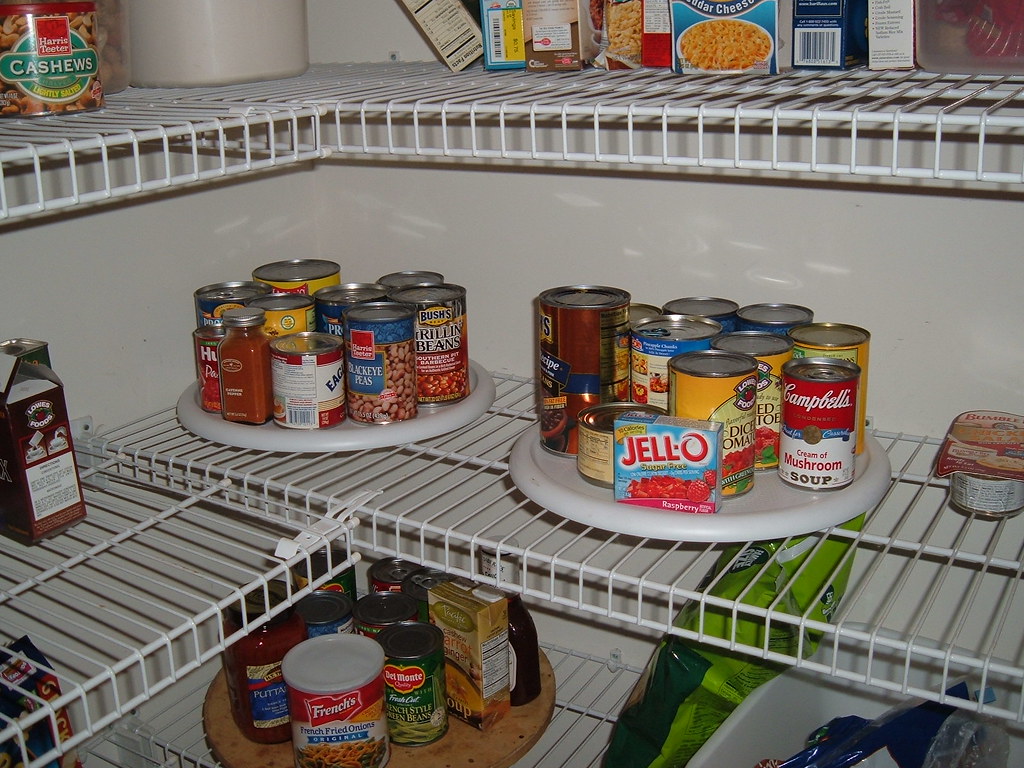
When it comes to Organizing Your Pantry for cleanliness and efficiency, lazy Susans and pull-out shelves are game-changers. These clever storage solutions not only maximize space, but also make it easy to access items, even those at the back of the shelf. Let’s take a closer look at how these pantry organizers can transform your space.
Lazy Susans are rotating trays that allow you to access items with a simple spin. They come in a variety of sizes and materials, making it easy to find one that fits your pantry’s needs. By using lazy Susans in your pantry, you can say goodbye to rummaging through crowded shelves and struggling to reach items in the back. You can use them to store spices, condiments, canned goods, and more, keeping everything within easy reach.
Pull-out shelves, on the other hand, are like drawers for your pantry. They slide out, giving you full access to the items stored on them. This makes it easy to see and reach everything in your pantry, eliminating the need to squat down and search through dark corners. One of the key benefits of pull-out shelves is that they can be customized to fit your specific pantry layout, making them a versatile solution for Organizing Your Pantry.
In summary, lazy Susans and pull-out shelves are essential tools for Organizing Your Pantry for cleanliness and efficiency. By incorporating these handy storage solutions into your pantry, you can save time, reduce frustration, and maintain a clutter-free space. Whether you’re a cooking enthusiast or just want to keep your pantry tidy, these organizers are a must-have for any home.
Ready to transform your pantry? Check out companies like The Container Store and Rev-A-Shelf for a wide selection of lazy Susans and pull-out shelves.
Label Like a Pro: Never Guess Contents Again
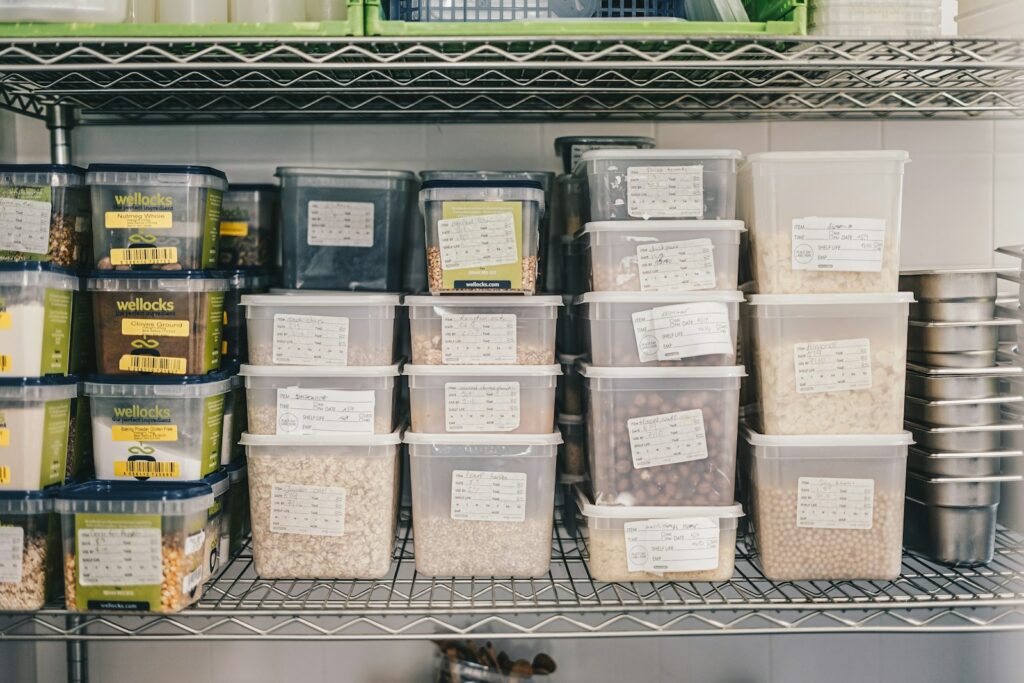
When it comes to organizing your pantry for cleanliness and efficiency, labeling your containers is a game-changer. No more guessing what’s inside that unmarked Tupperware or rummaging through boxes to find the right ingredient. With clear and easy-to-read labels, you’ll save time and reduce food waste.
To label like a pro, start by investing in quality label makers. Look for ones that are durable and easy to use with a variety of label sizes and fonts. Take the time to create labels that are clear and concise, using bold text for easy readability. Categorize your labels by food type, expiration date, or cooking instructions to keep your pantry organized and functional.
Consider using color-coded labels for added organization. For example, use red labels for spices, green for baking ingredients, and blue for canned goods. This visual cue makes it easy to locate what you need at a glance and adds a pop of color to your pantry shelves.
When labeling, be sure to include essential information such as the contents, date of purchase, and expiration date. This not only helps you stay on top of pantry inventory but also ensures that you’re using items before they expire. With clear, detailed labels, you’ll never have to play the guessing game again when it comes to your pantry contents.
| Pros | Cons |
| Easy to read and locate items | Initial time investment in labeling |
| Reduced food waste | Cost of label makers and supplies |
| Added visual organization with color-coded labels |
By implementing these labeling strategies, you’ll transform your pantry into a well-organized and efficient space. Say goodbye to clutter and confusion, and hello to a pantry that’s a pleasure to use. With clear and detailed labels, you’ll know exactly what’s inside each container without any guesswork. So, grab your label maker and get ready to label like a pro!
First In, First Out: The Rotation Rule
When it comes to organizing your pantry for cleanliness and efficiency, one of the most important rules to follow is the first in, first out (FIFO) rotation rule. This rule ensures that you are using the oldest items in your pantry first, preventing food waste and ensuring that nothing expires before you have a chance to use it.
To implement the FIFO rotation rule in your pantry, follow these simple steps:
- Label and Date: Start by labeling and dating all of your pantry items. This will help you keep track of when each item was purchased and ensure that you are using the oldest items first.
- Organize by Date: Arrange your pantry items so that the oldest items are at the front and the newest items are at the back. This will make it easy to see what needs to be used up first.
- Use in Rotation: When it comes time to cook, be sure to use the oldest items in your pantry first. This will help prevent food waste and ensure that nothing goes bad before it gets used.
By following the first in, first out rotation rule in your pantry, you can make sure that nothing goes to waste and that you always have fresh ingredients on hand. This simple system can help you save time, money, and reduce your environmental impact by minimizing food waste.
In addition to following the FIFO rotation rule, it’s also helpful to regularly clean and organize your pantry to ensure that everything stays fresh and accessible. By taking the time to implement these simple strategies, you can create a pantry that is not only organized and efficient, but also a joy to use.
Adjustable Shelving: Adapt to Your Needs
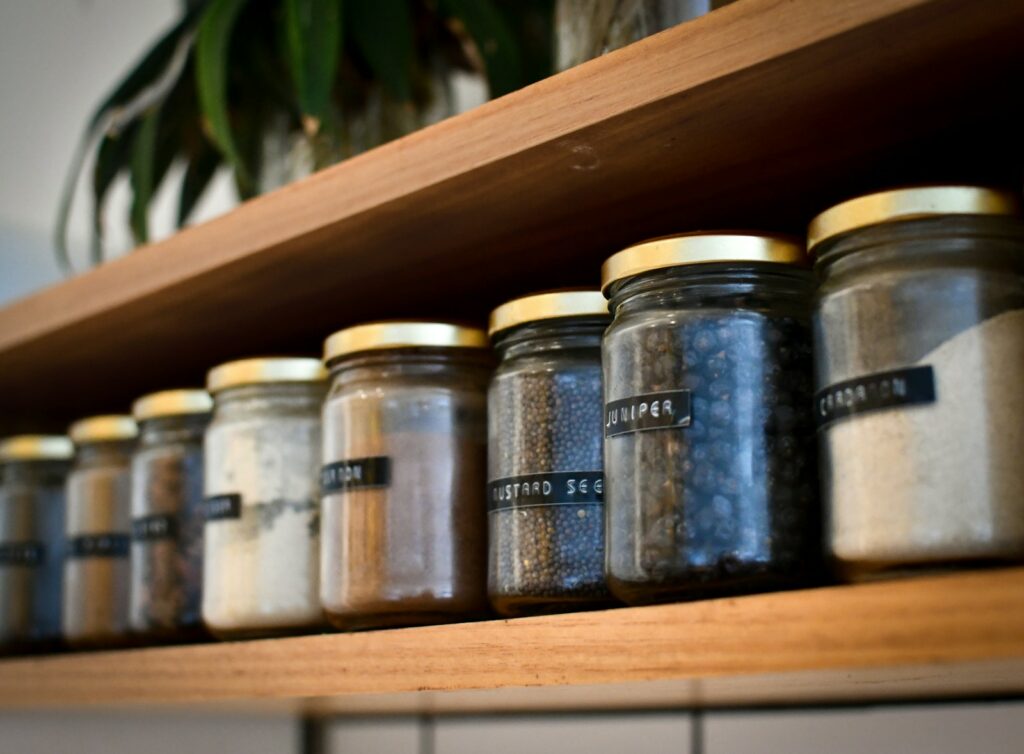
When it comes to Organizing Your Pantry for Cleanliness and Efficiency, adjustable shelving is a game-changer. These versatile shelves allow you to customize the layout of your pantry to fit your specific needs, making it easier to keep everything tidy and easily accessible. Whether you have tall cereal boxes or small cans of spices, adjustable shelving can accommodate it all.
One of the greatest benefits of adjustable shelving is the ability to maximize vertical space. By moving the shelves up or down, you can take advantage of every inch of space in your pantry. This is especially helpful for smaller pantries where space is at a premium. Additionally, adjustable shelving allows you to easily reconfigure the layout as your storage needs change over time.
Another advantage of adjustable shelving is the flexibility it provides for storing items of different sizes and shapes. You can create custom configurations to accommodate everything from bulky kitchen appliances to delicate glass jars. This level of adaptability makes it easier to keep your pantry organized and visually appealing.
When considering adjustable shelving options, look for sturdy, high-quality materials that can support the weight of your pantry items. Wire shelving is a popular choice, as it allows airflow and visibility, preventing stale odors and making it easier to find what you need. However, if you prefer a more polished look, wood or laminate adjustable shelving may be a better fit for your pantry aesthetic. Remember to measure your pantry space carefully before purchasing shelving to ensure a perfect fit.
Adjustable shelving is an essential tool for Organizing Your Pantry for Cleanliness and Efficiency. It provides the flexibility to adapt to your changing storage needs, maximizes space, and keeps your pantry looking neat and organized. Whether you opt for wire, wood, or laminate, investing in adjustable shelving will upgrade your pantry organization game to the next level.
Moisture and Pests: Safeguarding Your Supplies

Keeping your pantry organized is not only about cleanliness and efficiency, but also about protecting your supplies from moisture and pests. Here are some tips to help you safeguard your pantry items.
Moisture Control
Moisture can wreak havoc on your pantry supplies, causing food to spoil and packaging to deteriorate. To prevent moisture buildup in your pantry, consider the following:
- Use a dehumidifier to keep the air dry and prevent moisture from accumulating.
- Store items in airtight containers to keep out moisture and maintain freshness.
- Use moisture-absorbing products such as silica gel packets to help control humidity levels.
Pest Prevention
Pests like ants, roaches, and mice can infiltrate your pantry and contaminate your food. To keep pests at bay, follow these tips:
- Keep your pantry clean and free of crumbs and spills that can attract pests.
- Store food in pest-proof containers made of glass or plastic with tight-fitting lids.
- Use natural pest deterrents such as bay leaves, cloves, or peppermint oil to repel insects.
By taking these precautions, you can ensure that your pantry supplies stay fresh, clean, and free from moisture and pests. Keeping your pantry organized is not just about tidiness, but also about protecting the quality of your food.
Use Vertical Space: Stack Smarter, Not Harder
When it comes to organizing your pantry, making the most of vertical space can be a game-changer. By utilizing the height of your shelves, you can maximize storage capacity and keep your pantry clean and efficient.
Here are some creative ways to stack smarter, not harder, in your pantry:
Invest in Stackable Storage Containers
One of the most effective ways to use vertical space in your pantry is to invest in stackable storage containers. These containers come in various shapes and sizes and can be easily stacked on top of each other, allowing you to make the most of the vertical space in your pantry. Not only do they help keep your pantry organized, but they also make it easy to see what you have at a glance.
Install Adjustable Shelving
Consider installing adjustable shelving in your pantry to make the most of the vertical space. This will allow you to customize the height of your shelves to fit your storage needs. You can easily adjust the shelves to accommodate taller items, such as cereal boxes and cooking oils, without wasting any vertical space.
Utilize Over-the-Door Organizers
Make use of the often overlooked space on the back of your pantry door by installing over-the-door organizers. These organizers come in a variety of styles and can be used to store spices, small jars, and other pantry items. By utilizing this vertical space, you can free up valuable shelf space for larger items.
Consider a Pull-Out Pantry System
If you have a larger pantry or a walk-in pantry, consider installing a pull-out pantry system. These systems make use of vertical space by allowing you to easily access items at the back of your pantry without having to reach or strain. With pull-out shelves, you can maximize every inch of your pantry’s vertical space while keeping everything organized and easily accessible.
Using the vertical space in your pantry efficiently is a great way to keep it organized and clutter-free. By implementing these tips, you can transform your pantry into a clean and efficient space that makes meal prep and cooking a breeze.
Maintain with a Monthly Audit: Keep It Systematic
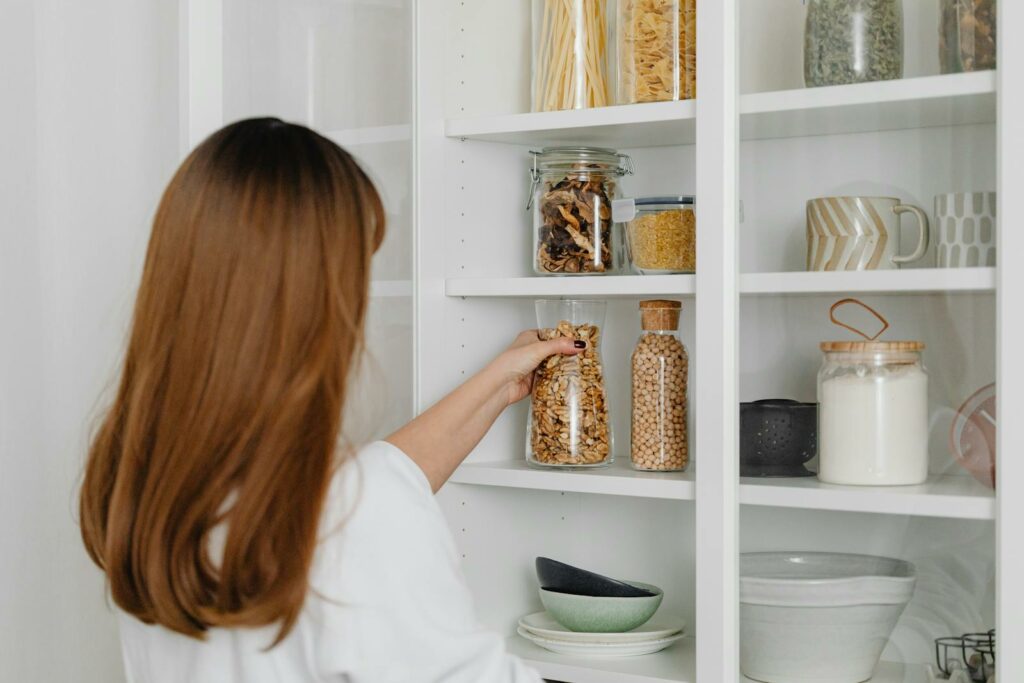
Once you have organized your pantry for cleanliness and efficiency, the key to maintaining this state is with a monthly audit. Keeping your pantry organized requires systematic and regular checks to ensure everything stays in its rightful place. Here are some tips to help you keep your pantry in top shape with a monthly audit:
Set a specific day each month: Choose a day each month to conduct your pantry audit. This will help you establish a routine and ensure that you don’t forget to do it.
Check for expired items: Take a close look at the expiration dates on your pantry items. Remove any expired foods and make a note to replace them on your next grocery trip.
Reorganize as needed: During your monthly audit, take the opportunity to reorganize your pantry if needed. Sometimes, items can get misplaced or mixed up, so take the time to put everything back in its proper place.
Clean as you go: While auditing your pantry, take the time to wipe down shelves and containers. Keeping your pantry clean is essential for maintaining a sanitary and efficient space.
By conducting a monthly audit, you can ensure that your pantry stays organized and efficient. It will also help you stay on top of any expired or spoiled items, ensuring that you always have fresh and safe foods on hand. Don’t forget to set a reminder on your phone or calendar to help you stay consistent with your monthly audits.
Questions & Answers for Organizing Your Pantry for Cleanliness and Efficiency
What are some common pantry organization mistakes?
Common pantry organization mistakes include not using containers to store loose items, allowing expired food to accumulate, and not utilizing all available space.
How can I keep my pantry clean and free of pests?
To keep your pantry clean and pest-free, regularly wipe down shelves and surfaces, store food in airtight containers, and promptly remove any expired or spoiled items.
What are some space-saving tips for organizing a small pantry?
For a small pantry, consider using door racks, stackable bins, and shelf risers to maximize vertical space and keep items easily accessible.
How can I categorize and arrange items in my pantry for efficiency?
Arrange items in your pantry by categories such as grains, canned goods, snacks, and baking supplies. Use labels or clear containers to easily identify and access what you need.
What are some creative storage solutions for organizing a pantry?
Creative storage solutions for pantry organization include using hanging baskets for onions and potatoes, repurposing magazine holders for storing cans, and using tension rods to create adjustable shelves.
How often should I declutter and reorganize my pantry?
It’s a good idea to declutter and reorganize your pantry every 3-6 months to remove expired items, reevaluate storage solutions, and ensure everything is still easily accessible.
How can I create a meal planning system that incorporates my organized pantry?
Utilize your organized pantry to create a meal planning system by taking inventory of what’s available, creating a shopping list for any missing ingredients, and organizing items by meal type or recipe.
What are some tips for maintaining a clean and organized pantry on a daily basis?
To maintain a clean and organized pantry daily, make it a habit to put items back in their designated spots, regularly check for expired items, and quickly clean up any spills or crumbs.
How can I involve my family in maintaining an organized pantry?
To involve your family in maintaining an organized pantry, consider assigning each family member a specific task, such as organizing a certain section or checking for expired items, and making it a team effort to keep the pantry tidy.
What are the benefits of having a clean and organized pantry?
A clean and organized pantry not only makes it easier to find ingredients and cook meals, but it also helps reduce food waste, saves time and money, and creates a more visually appealing space in your kitchen.
The Way Forward
And there you have it, folks! With these easy and practical tips, you can transform your pantry into a clean, efficient, and organized space. No more wasting time searching for ingredients and no more expired products lurking in the back. By implementing these strategies and staying consistent with regular maintenance, you can keep your pantry in top shape for years to come. Happy organizing!
